Retnayu Prasetyanti, Andy Fefta Wijaya, M. R. Khairul Muluk
Faculty of Administrative Science, Department of Public Administration, University of Brawijaya, Malang, 65145, East Java, Indonesia
Correspondence to: Retnayu Prasetyanti, Faculty of Administrative Science, Department of Public Administration, University of Brawijaya, Malang, 65145, East Java, Indonesia.
| Email: |  |
Copyright © 2014 Scientific & Academic Publishing. All Rights Reserved.
Abstract
The trend of urban modernization in Surabaya, East Java, Indonesia is blamed for its irresponsibility on the negative impacts against the environmental sustainability. In a practical realm, solid waste problem in Surabaya recently threatens the quality of environment and health of the people. This fact is worsened by the improper solid waste management system and the people neglect. Meanwhile, high economic orientation has seized the concern of government and also people of Surabaya for years. This economic mindset carries away the initiative of sustainable development by putting aside environmental challenges and giving more preference on the trade expansion. Consequently, the economic development perspective remains complex problems on the environmental preservation, particularly the solid waste problem. The enormous population in Surabaya has contributed to the overcrowded solid waste volume that reached a thousand ton per day. This severe situation does require a serious action from local government of Surabaya jointly works with supporting stakeholders (community, Non-Governmental Organization (NGO) and donor). Besides that, a systematic arrangement of solid waste management scenario is also preferred to be developed by conducting a depth research and analysis. Hence, a breakthrough scenario planning is necessary to formulate by developing system dynamic analysis. This tool of analysis is part of hard system methodology from systems thinking framework. According to system dynamic analysis, community participation is assessed to be very effective alternative for the future solid waste management system. A gender emancipation and pro poor based solid waste management system may be built to mitigate negative impacts of solid waste problem. Women and scavenger development may also give solution for both environmental sustainability and economic matter. Further, government may open a wide space for community participation as a willing to provide a better life both for the environment and the people.
Keywords:
Solid waste management, Systems thinking, System dynamic, Community empowerment, Community participation
Cite this paper: Retnayu Prasetyanti, Andy Fefta Wijaya, M. R. Khairul Muluk, Developing Community Based Solid Waste Management Scenario in Surabaya, East Java, Indonesia: An Analysis Using System Dynamic Method, International Journal of Applied Sociology, Vol. 4 No. 1, 2014, pp. 1-9. doi: 10.5923/j.ijas.20140401.01.
1. Introduction
Surabaya, the capital of East Java Province, Indonesia, nowadays, is well-known for its serious environmental problems. This metropolitan city has suffered from severe solid waste problem over last 8 years; many neighbourhood associations lived aside with high challenges in term of bad environmental condition. There, many increased negative impacts of littering, drainage clogging, and burning of waste was more and more common for the community. Flooding was often happened, and even many of the community, at that time, used the flood to get rid of their solid waste by throwing it to the flowing water (ESP: USAID/Indonesia, 2006, p. 16). Solid waste, recently, is claimed as a multidimensional problem; it no longer becomes a simple environmental problem, however, solid waste particularly relates so close to people’s economic and social problem. This means that solid waste problem in Surabaya was unexpectedly caused by the high economic and social motive, so that, a massive urbanization happened and contributed to the uncontrolled population density in Surabaya. This phenomenon dragged more complex problems interrelate to the presence of migrants, vagrants and slum settlements spread over river and railway areas. Factually, these people have less awareness on a proper solid waste management that finally declines the quality of environment in Surabaya. In another case, people ignorance mostly costs more negative impacts on the environmental condition, moreover, improper solid waste management system, at that moment, still remains unsolved. Surabaya (as many other big cities across Indonesia), doesn’t have a proper drainage, sewage, and waste management system. The open dumping system disposes solid waste with no permanent solution; meanwhile, there is no clear deal of punishment applied by the government officials in taking an action against those who disobey rules to treat solid waste properly. In 2013, over 3 million people of Surabaya produced 1.200 ton solid waste per day, and these people rendered solid waste volume increase until 5% per year (Prasetyanti, 2012, p. 9); without a good solid waste management, it is no longer matter of number, but a disaster for the future environment and health of the living. Solid waste and environment actually can affect the quality of individual and collective lives, as well as the economic choices they make. Thus, local government of Surabaya needs to balance the environmental policy with the economic matter because there is often a big different on how government more intensely concerns on the economic policies rather than the environmental policies; however, as same as economic, environment has to be sustained and kept.Solid waste problem in Surabaya needs more strategic approach; it cannot merely count on government action or centralistic policy oriented. Solid waste management in Surabaya needs a good development approach; it relies on bottom up approach which is commonly understood as community empowerment approach (Ife and Tesoriero, 2006). Community empowerment truly respects community participation through local human resource enhancement. In another hand, solid waste problem requires more than just community participation, it needs an appropriate method and analysis since solid waste problem is always dynamic, multidimensional, and complex. Practices of community empowerment approach in the environmental preservation program also needs more assistance from other sectors as a means to alleviate the unintended barriers or failure. An exclusive partnership with NGO and donor may become very promising to succeed the program achievement. Community participation through community empowerment framework may exactly become the best scenario for the overwhelming solid waste problem in Surabaya, however, the power holder cannot directly take a decision without a depth research and analysis whether or not community empowerment will clearly solve the problem. Local government of Surabaya needs to consider measuring all the consequences that possibly happen, they must have more calculation and consideration regards the best solid waste management system applied in Surabaya. For those reasons, the public officials really need to develop breakthrough policy scenarios that precisely can support government and community movement in managing solid waste problem.According to this problem, this research digs a deeper and detailed analysis on what the local government needs to admit reformulating policies and strategies of solid waste management more seriously. This research also believes that further, all stakeholders must incredibly smart in identifying the real problems of community and what exactly community needs. The results of the study offer a clear explanation between causes and effects of the real problem which are dynamically changing overtime. The development of system dynamic analysis tries to sort various problems in order to ease the process of identification and formulation in determining the effective alternative scenarios of the sustainable solid waste management. This research also provides preferences of the appropriate scenarios to overcome the problems. It uses the framework of systems thinking and the method of system dynamic analysis to understand the complexity of solid waste problem more accurately by arranging all details of solid waste problem systemically to offer the best recommendation with a systematic reason and explanation towards solid waste management problem in Surabaya.
2. Problem Setting
Metropolitan city of Surabaya experienced with complex solid waste management problem associated with less managed solid waste management system. This research will have strong focus on the system dynamic analysis and scenario testing and continued by a sequent analysis of the formulation solid waste management scenario that involves partnership among communities. Attempts to resolve this situation include consideration of appropriate scenario or policy using the approach of community empowerment and community participation principle to keep the environment sustainability by enlightening local human resource.
3. Theoretical Framework
Theoretical framework reveals some theories to provide a supporting qualitative analysis. The determining theories are community empowerment (Ife and Tesoriero, 2006) and community participation (Arnstein, 1971). The theory of community empowerment mainly talks about community empowerment model that inspires the scenario development of gender and children based solid waste management; meanwhile, the theory of community participation mainly explains about the participation ladder that defines categories and characteristics of community involvement.Table 1. Participation Ladder
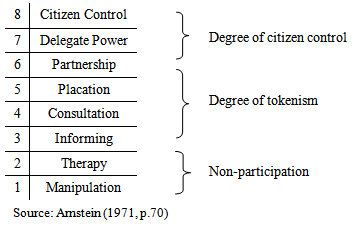 |
| |
|
Table 2. Community Empowerment Model
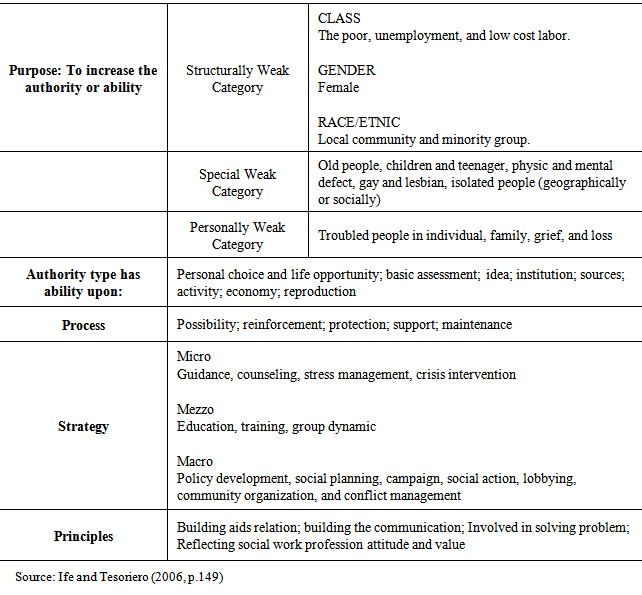 |
| |
|
4. Social Setting of Research
Surabaya is a big city with high economic prospect for its biggest potential of economic centre in East Java. Recently, when urban development and urbanization trends are fast growing in the city that never sleeps, Surabaya has more complex environmental problems than its economic profits. The city of Surabaya has high challenges for its enormous population and pressure for shelter and services. There is uncontrolled urbanization; 200 people are claimed to come to Surabaya per month to get a new job, some stay and some leave. The other problems are City zoning management and slum settlement. The city development is intended to be more concerned on services for the Central Business District (CBD), so that, it often regrets the open space for public facilities and green areas. Meanwhile, slum settlements are very disturbing in Surabaya for its role in spreading solid wastes across remote areas of Surabaya. Clearly, this habit shows low awareness of community that results a bad solid waste management.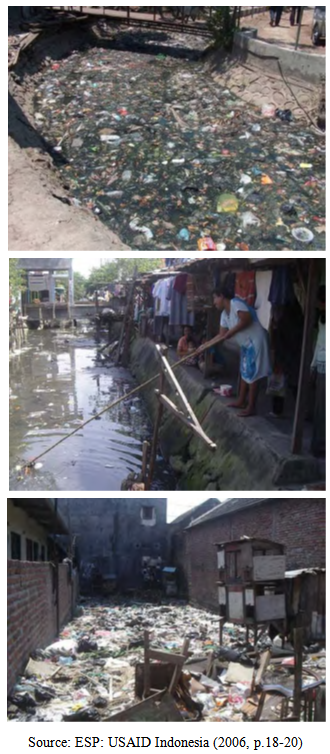 | Figure 1. a) Solid wastes filled in the river in Wonokromo, Surabaya, b) Women tried to push garbage to follow the river flow in Gading, Surabaya, c) Open dumping site in Gading, Surabaya |
5. Research Method
5.1. Type of Research
This research is designed to analyze and create alternative model uses qualitative and quantitative research; it uses a combination method Creswell calls as dominant less dominant design (Creswell, 1994, p.179). Further, this research also uses a certain research approach; systems thinking approach (Senge, 1994), and a certain research analysis method; system dynamic method (Coyle, 1996).
5.2. Focus of Research
This research focuses on the formulation of alternative solution for solid waste management by system dynamic analysis includes some steps; 1) The development of Causal Loop Diagram (CLD) and Stock Flow Diagram (SFD), 2) Leverage testing, and 3) Scenario formulation.
5.3. Type and Source of Data
The data used in this research is collective secondary data obtained from various sources of Surabaya government website or the Central Bureau of Statistics and literature that includes any related information. Table 3. The Data Used for System Dynamic Analysis
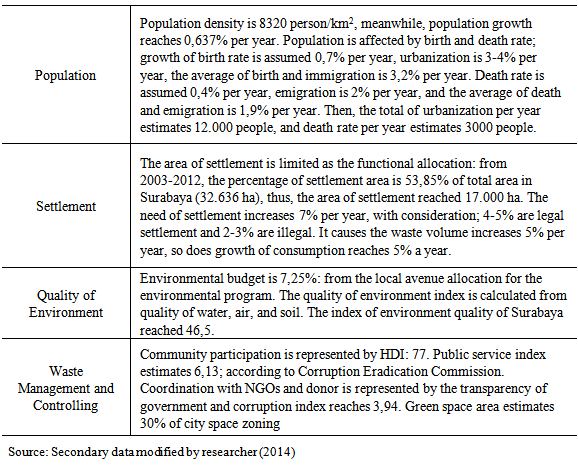 |
| |
|
5.4. Data Analysis
Data analysis method in this research is system dynamic that can be used both qualitatively (supported by the theories of community empowerment and community participation) and quantitatively. Qualitatively, system dynamic analysis can be used to capture the workings of a system as a tool of thinking and understanding. However, it can be converted into a quantitative model of simulation and optimization to support a policy design (Muluk, 2007, p.320). System dynamic was developed from the discourse of systems thinking. The founder of system dynamic in 1961, Jay Forrester, defined system dynamic as, “the investigation of the information feedback characteristics of (managed) systems and the use of models for the design of improved organizational form and guiding policy” (Forrester in Coyle, 1996, p.9). The steps of system dynamic analysis used in this research are Coyle’s system dynamic analysis that commonly uses both qualitative and quantitative analysis. First step is Problem Recognition; it mainly discusses about description of solid waste problem by making the input-output diagram. Second step is Problem Understanding and System Description; it systematically discusses more about problem understanding by giving an overview of solid waste management system through CLD and SFD. Third step is Qualitative Analysis that is importantly used to obtain a better description of the challenging problems. Fourth step is Simulation Modeling; it is the most critical step of analysis. Here, CLD and SFD are converted into a simulation model that can be operated in a computer language facilitates the achievement of the higher processing speed and convenience to improve and develop the model. The last step taken is Policy Testing and Design. It is the final step to design policies or scenarios and test them by simulating potential changes to the system to see the impacts. The overview of system dynamic analysis phases made by Coyle (1996, p.10-11) is drawn below: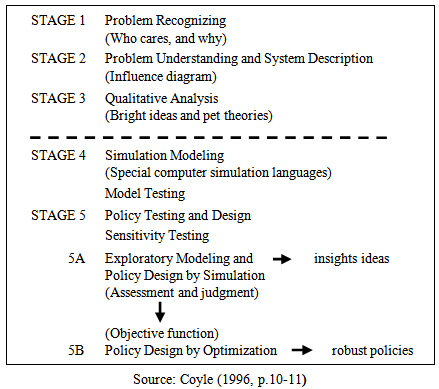 | Figure 2. Stages of System Dynamic |
6. Result and Discussion
The unsolved solid waste management problem in Surabaya particularly has become a public concern for its huge complexity. Solid waste problem came up with complicated problems relate to uncontrolled population, irregular settlement, improper sanitary and sewage system, low environmental awareness, and also bad solid waste management system. These severe problems can be solved by system dynamic analysis which stresses on model testing and scenario making. In system dynamic analysis, solid waste management is explained as system, meanwhile, some tested subsystems are called as flow or rate and solid waste volume is determined as stock or level of the system.Model testing analysis will assess the compatibility of all subsystems and decide leverage of system. In this study, dynamic model is made and tested by Powersim 2.5d constructor software. This tool of analysis can significantly evaluate the settled subsystems, which are; population, settlement, quality of environment, and waste management and controlling. Those subsystems are the influenced factors of solid waste management system and desired to be a scenario making consideration. Previously, the dynamic model is identified by an analysis of solid waste problems through the input output diagram explains the complexity of solid waste problem. The diagram is captured below: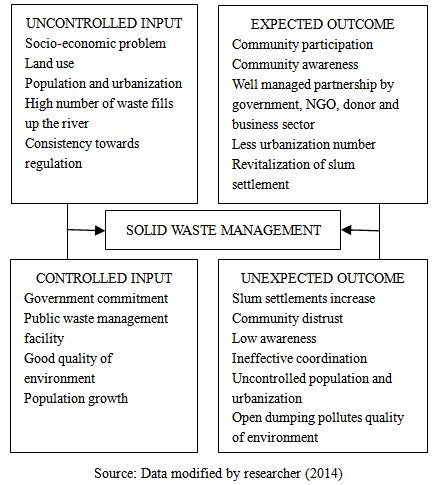 | Figure 3. The Input Output Diagram |
The construction of subsystem is created by several assumptions which are collected from secondary data source, such as: population, settlement, community participation, public service, quality of environment index, and many others. Those data are taken from literature review and explored to conduct a scenario analysis through Causal Loop Diagram (CLD) and Stock Flow Diagram (SFD) arrangement. These CLD and SFD are important steps to find leverage of system and discover some possible scenarios to provide solution towards better solid waste management system. CLD and SFD of solid waste management system can be seen below: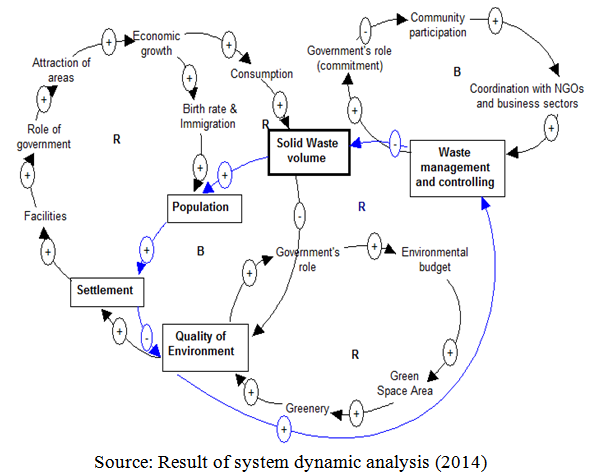 | Figure 4. Causal Loop Diagram (CLD): Solid Waste Volume |
CLD above explains the relationship among subsystems and variables which also signs the negative and positive relationships among subsystems (balancing loop and reinforcing loop). CLD is a derivation of subsystem’s variable that helps researcher considers determining the most affecting variable in solid waste management system. The analysis of community empowerment relates closely to subsystem of waste management and controlling which explains about community participation. In this case, it represents the degree of community empowerment, or, in the other words, the higher community participation, the higher community empowerment degree. From SFD analysis of waste management and controlling, community participation is directly affected by both government’s role and coordination with NGOs and donor. The relationship between government’s role and community participation creates negative relationship which results a contradictive respond.In the theory of community empowerment, the role of government is crucial since government plays as a policy maker, however in the implementation level, government needs to widen a free space for community participation. The role here means more to the elite local role as a policy maker not an executor. The negative relationship is a logical result from the independency of community towards government’s role; when government’s role is high then community participation is low, or, in another explanation, when government takes over more to the process of solid waste management then community will depend more on active role of government.The analysis of CLD heads to qualitative analysis with a sequent explanation of the affecting forces in solid waste management scope. Population and settlement are the one that have strong relationship to the uncontrolled solid waste volume, then, it finally reflects a bad condition of the environmental quality in Surabaya. The other supporting qualitative analysis is the theoretical analysis of community empowerment and community participation. This condition refers to the strategy of Ife and Tesoriero (2006, p.149) focuses on the development of structurally weak category on gender empowerment by the development of mezzo strategy through training and education. Certainly, in this case, community participation in Surabaya is formed as women emancipation movement through development of the environmental cadre in solid waste management.In community based solid waste management, the relationship among community participation and NGO/ donor rises highly despite the role of government decreases, therefore, there is a reinforcing loop connects community participation and coordination with NGO/donor or business sector. The fact that NGO/donor and business sector plays more active in the implementation level than government, somehow, needs to be analyzed further through the analysis of SFD. SFD helps the researcher conducts assessment of scenario formulation that impacts on the betterment of solid waste management system. Besides that, the arrangement of SFD directs to the determination of the system leverage. 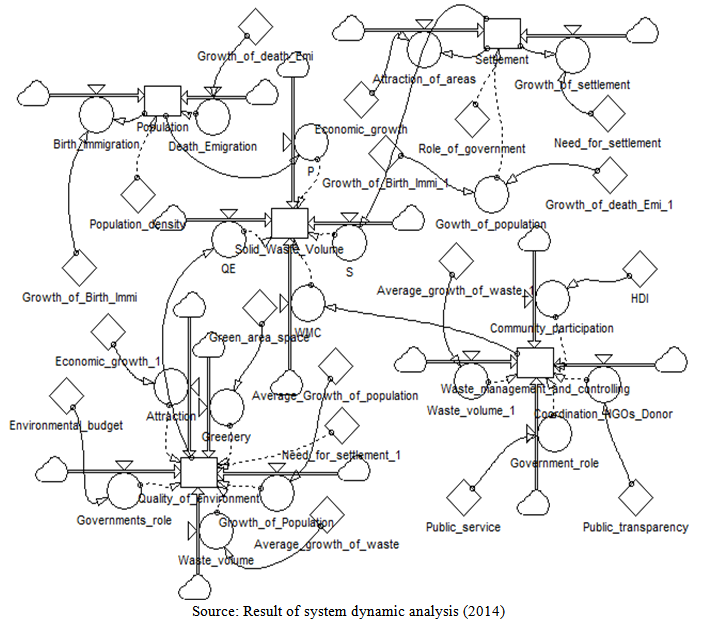 | Figure 5. Stock Flow Diagram (SFD): Solid Waste |
From the analysis of SFD, the calculation of solid waste reduction is started from 2010 and forecasted until 2050; the number is shown below:Table 4. Comparison of Solid Waste Volume (Prediction in 2050)
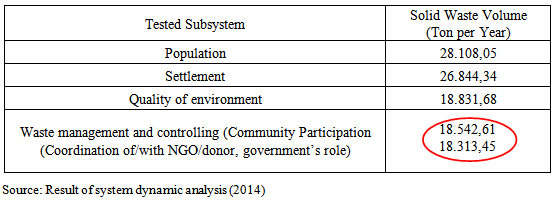 |
| |
|
Based on the table above, waste management and controlling produced less solid waste volume than other subsystems. It proved that waste management and controlling elements includes community participation, coordination of/with NGO/donor, and government’s role can attain success in reducing solid waste volume. According to SFD analysis and the data exploration, community participation involvement can reduce solid waste volume from 18.542,61 to 18.313,45; it is 229,16 total reduction in 2050; less than normal solid waste volume (without community participation). However, NGO/donor and government role play less effective than community participation in decreasing solid waste volume.In SFD analysis, community participation, one of subsystems of waste management and controlling, give more significant solid waste reduction result than elements of coordination of (with) NGO/donor, and government role. The data simulation shows that these three elements constantly have different solid waste reduction from 2010 until 2050; however, the most determining variable is community participation. The graphic can be seen below: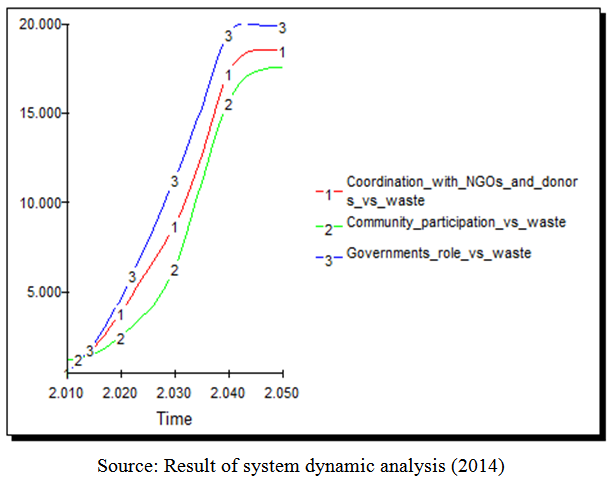 | Figure 6. Graphic of Solid Waste Volume |
From the figure shown above, the elements of waste management and controlling show different result of system dynamic testing. This analysis proves the strengths and weaknesses of each element by showing different solid waste volume in the final result. The lowest number of solid waste belongs to community participation which actually becomes leverage of system. Therefore, the scenario of solid waste problem must be arranged by deriving some solutions in community participation scope of analysis.In practice, solid waste problem has not only become enemy against environment but also people. This fact implied solution that government is insisted to be more intense in developing an appropriate strategy occupies community participation as a role model of human resource enhancement towards environmental preservation activity. This condition fits to the analysis of SFD that performs community participation as the most effective way to solve solid waste management problem in Surabaya. In the city solid waste management and controlling system, the biggest challenge found in the process of community participation. Community is assumed as a major actor who plays more active fits to the principle of community empowerment (Ife and Tesoriero, 2006). Problems of population, settlement, and environmental degradation will not too problematic if community participation is well and properly managed. Therefore, the efforts and forces need to be focused on the maintenance of the active role of community in waste management and controlling system.Local government needs to coordinate simultaneously with other actors in developing policies and programs of community based solid waste management and controlling in Surabaya. For that reason, the scenarios are important to be built and chosen by considering the possibility and priority. Some alternative scenarios are: Women Based Solid Waste Management (WBSWM) in Surabaya Green and Clean Program with the programs are Women Based Solid Waste Recycle Cooperative/WBSWRC and School Based Solid Waste Cooperative/SBSWC. The form of cooperative development is chosen for its principles that describe the economic basis of the Indonesian people that have been owned far a long time before the private banking system is previously well known.The future development of WBSWRC is expected to produce local commodity with national and international standard. It means that women do not only give contribution to their environment, even more give economic benefits to their family and group of community. Besides that, by developing WBSWRC, women can contribute in the social, economic, and environmental based activities that finally will enrich their knowledge and capacity.In the other side, women also actively become an environmental promoter in SBSWM who tries to introduce environmental education in schools through the national curriculum. This is assumed as an appropriate solution since many environmental problems scared by individuals at that time are wished to be mitigated through education, both formal and informal education. Schools are categorized as place of universe where family background, economic level diversity, ethnicity and culture are collected and lived. Both formal and informal schools are an appropriate place to change behaviour patterns towards caring and protection of the environmental preservation.Currently, environmental education in schools does not directly benefit on the environmental preservation. That is because the approach of the environmental education in schools is still very theoretical based education. Practical level of the environmental education is still rarely done by schools. It needs more efforts refer to more practice than the theoretical learning since the students need to live into the real life. The direct teaching/learning process in schools and implementation of environmental based education given to students are expected to be internalized in their daily life. The application of waste management concept in schools requires the students to implement the idea of being friendly to the environment independently in their home circumstances. Then, further, it motivates them to become agents of change in the wider community level.Cooperative uses the principle of togetherness and caring as factors to activate community independency; it also relies on social capital that continuously able to excavate the potentiality of local community. In the other sides, the development of WBSWRC and SBSWC comes from the idea of social capital development by delivering an understanding that solid waste is not only environmentally but also economically beneficial. The right partnership will combine the social and economic capital in the form of cooperative. In this activity, women play as cadre, member, motivator, and manager on every recycle activity. Recycle, reuse, reduce are principles of solid waste management that can be succeeded during the program implementation; it also obligates children in school to do waste collection, segregation and solid waste recycling to get advantages from waste.Another scenario is Community-Scavenger Partnership Based Solid Waste Management (CSPBSWM). The idea of CSPBSWM emerged since community and scavenger are those who utilize solid waste and contribute in solid waste management in city. This scenario seems very risky because community and scavenger are willing to get economic value of solid waste, thus, conflict ever often happened between them. Moreover, some neighbourhood associations clearly ban the existence of scavenger in their area; it is simply because scavenger does not only take waste but also often grabs people stuffs with no regrets. 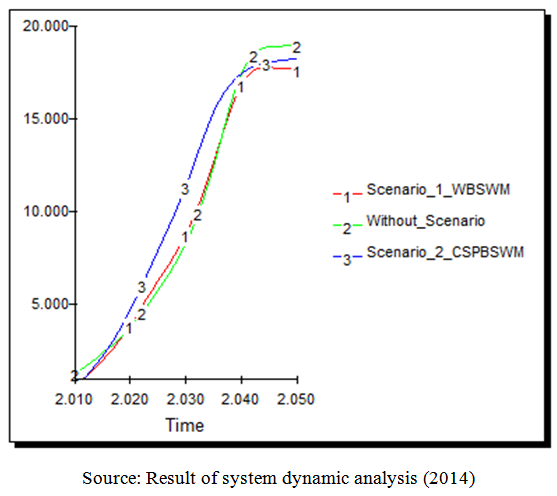 | Figure 7. Graphic of Solid Waste Volume (Before and After WBSWM and CSPBSWM Scenarios) |
There are some problems about scavenger’s role in solid waste management have been concluded by the researcher. In a daily life, conflicts between community and scavenger are mainly caused by some reasons; scavengers often steal people stuffs (30%), scavengers often act impolitely and rough (33%), scavengers often look stinky and slummy (20%), scavengers bring disease (10%), scavengers have a bad willing (7%). However, role of community is critical, so does scavenger’s. Community and scavenger can play as distributor and collector. Community holds waste collection and segregation a, meanwhile; scavengers accept waste from community by giving some incentive. It commonly happens in community daily life, but still, there is no clear regulation to avoid conflict among others. Somehow, this action will help community to reduce solid waste volume in environment, even though with or without doing recycle.To get a whole description about those scenarios, the comparison of scenarios result on solid waste volume can be seen in figure and table below:Table 5. Comparison of WBWSM and CSPBSWM Scenarios
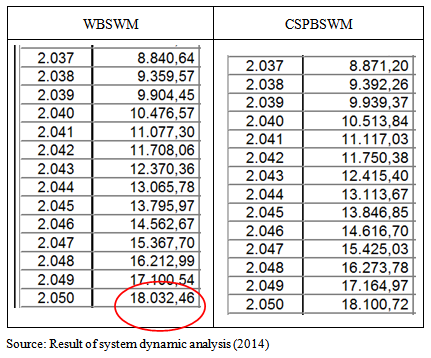 |
| |
|
From the figure above, WBSWM and CSPBSWM are affective to decrease solid waste volume in Surabaya. Simulation from 2010 until 2050 shows WBSWM has less solid waste volume than CSPBSWM; 10.032,46 ton waste per year. It may because WBSWM is more flexible and acceptable; moreover, the topic of women emancipation based community empowerment is highly supported governments in developing countries, particularly in Surabaya, Indonesia. However, both scenarios are quite eligible to be implemented. In the perspective of technical feasibility, WBSWM and CSPBSWM do not exactly need an advanced technology, but needs good creativity, knowledge and spirit. In the perspective of economic and financial possibility, both scenarios also become more efficient without high budget to spend. WBSWM and CSPBSWM can be conducted jointly with the private, NGO, and donor. In the perspective of political viability, WBSWM is quite easy to be permitted by governments, however, they needs to be more committed on special environmental program based women and scavenger through CSPBSWM. In the perspective of administrative operability, both scenarios need a serious performance of the organization and a proper management strategy and coordination in the implementation process. Thus, the coordination among actors can be enhanced well.
7. Conclusions and Recommendations
Critical problems in Surabaya (massive population rate, unsettled settlement, bad quality of environment, and improper waste management and controlling) have made severe solid waste impacts. By the idea of system dynamic analysis, the selective scenarios made are Women Based Solid Waste Management (Women Based Solid Waste Recycle Cooperative and School Based Solid Waste Cooperative programs) and Community-Scavenger Partnership Based Solid Waste Management. These scenarios may become very useful to keep environment clean by controlling solid waste management based community and scavenger approach.Community based solid waste management represents women as environmental cadres can promote community empowerment based environmental preservation program. In this activity, women aim to give training and education (mezzo strategy) about a proper solid waste management. This phenomenon implies potential adoptability of the environmental cadre practice in many other cities across country. In this case, community empowerment is intended to be tangibly succeeded in developing community self independence and motivation for women to move more active as a promoter of community based solid waste management in their family and home environment.In Indonesia, scavengers contribute a big role in city solid waste management. They can decrease 5% until 20% of total solid waste volume. Plastic wastes is often more valuable for scavengers to earn some money and it shows that they have valuable means to keep environment clean from unmanaged plastic wastes. Scavengers can be promoted to hold solid waste recycle by assisting government officials and women or environmental cadres to manage an appropriate solid waste management.Development of WBSWM and CSPBSWM may be considered as alternative ways to solve solid waste problem in Surabaya particularly, and Indonesia generally. These programs share and give education, awareness, sympathy and tolerance among low-middle class people. Meanwhile, it will not ever be easy to attain. Women and scavengers may ask governments to hold more comprehensive collaboration among actors. For that reason, the active role and strong commitment of governments are really important to be maintained. The understanding and admittance of the international actor existence is also important in this global world; it is supported by the theory of Sound Governance that the role of non state actor and international existence can support the credibility of governance process (Farazmand, 2004, p.16). The existence of international actor is such a help if the government can utilize it in a proper way. The presence of donor agencies or other supporting international actors will be more helpful with coordination between NGO and academic practitioner. The other local resources come up from a jointly work of university student and community; university student could be a field worker who helps community, then NGO will be a watch dog who will also control the program.
ACKNOWLEDGEMENTS
The writer dedicates big appreciation to Drs. Andy Fefta Wijaya, MDA, Ph.D, Dr. M. R. Khairul Muluk, M.Si, Prof. Dr. Bambang Supriyono, M.S, and Dr. Siti Rochmah, M.Si who have given advices, suggestions, critic, and supervision during the process of finishing the research.
References
| [1] | Arnstein, Sherry R., Eight Rungs on the Ladder of Citizen Participation in Edgar S. Cahn and Barry A. Passet, Citizen Participation: Affecting Community Change, New York: Praeger Publishers, 1971. |
| [2] | Coyle, R.G., System Dynamics Modelling: A Practical Approach. London, Chapman & Hall, 1996. |
| [3] | Creswell, John W., Research Design: Qualitative and Quantitative Approaches, Thousand Oaks, California: Sage Publication, 1994. |
| [4] | ESP: USAID Indonesia, Comparative Assessment Community Based Solid Waste Management (CBSWM); Medan, Subang, Bandung, and Surabaya. Development Alternatives, Inc. for the United States Agency for International Development under Contract No. 497-M-00-05-00005-00, November, 2006, leaflet p.16, 18-20. |
| [5] | Farazmand, A., Sound Governance: Policy and Administrative Innovations, Westport, CT, Praeger, 2004. |
| [6] | Ife, J. and Tesoriero, F., Community Based Alternatives in an Age of Globalization, Australia: Pearson Education, 2006. |
| [7] | Muluk, M. R. K., Menggugat Partisipasi Publik dalam Pemerintahan Daerah, Malang: Bayumedia-FIA-University of Brawijaya, 2007. |
| [8] | Prasetyanti, Retnayu, “Evaluating The Role of The United States Agency for International Development (USAID) in Community Based Solid Waste Management (CBSWM) Program: An Analysis Using Analysis of Variance (ANOVA)”, Undergraduate Thesis, Malang: University of Brawijaya, 2012. |
| [9] | Senge, Peter M., The Fifth Discipline: The Art and Practice of The Learning Organization, Paperback Edition, New York: Currency Doubleday, 1994. |








 Abstract
Abstract Reference
Reference Full-Text PDF
Full-Text PDF Full-text HTML
Full-text HTML



